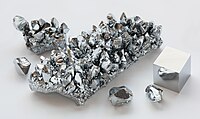
Photo from wikipedia
In this study, the effects of red mud (RM) dosage during the co-reduction roasting of lowgrade laterite ore and RM were investigated. The expanded test was conducted under the following… Click to show full abstract
In this study, the effects of red mud (RM) dosage during the co-reduction roasting of lowgrade laterite ore and RM were investigated. The expanded test was conducted under the following optimized conditions: RM-1 dosage of 15 wt%, anthracite dosage of 13 wt%, a roasting temperature of 1300oC, and roasting time of 3 h. Ferronickel powder was obtained with a nickel grade of 1.95 wt%, iron grade of 83.25 wt%, and nickel and total iron recoveries of 94.71 wt% and 95.98 wt%, respectively. The addition of RM improved the recovery of nickel and total iron in ferronickel powder. The reason was because of the increased intensity of the diffraction peaks of kamacite and iron, and the ferronickel particles grown due to the liquid phase were easier to achieve at a lower melting point. The industrialscale test results showed that ferronickel powder was obtained with average nickel and total iron grades of 1.76 wt% and 86.46 wt%, respectively, which indicated the successful industrial-scale test of co– reduction roasting. Thermodynamic analysis theoretically illustrated the feasibility of the co–reduction of low-grade laterite ore and RM. Increased roasting temperature promoted the reduction of iron oxide and nickel oxide.
Journal Title: Physicochemical Problems of Mineral Processing
Year Published: 2021
Link to full text (if available)
Share on Social Media: Sign Up to like & get
recommendations!